Ready to take your leg workouts to the next level? Here’s a detailed look at how to use the leg press machine, including common mistakes lifters make with this leg machine.
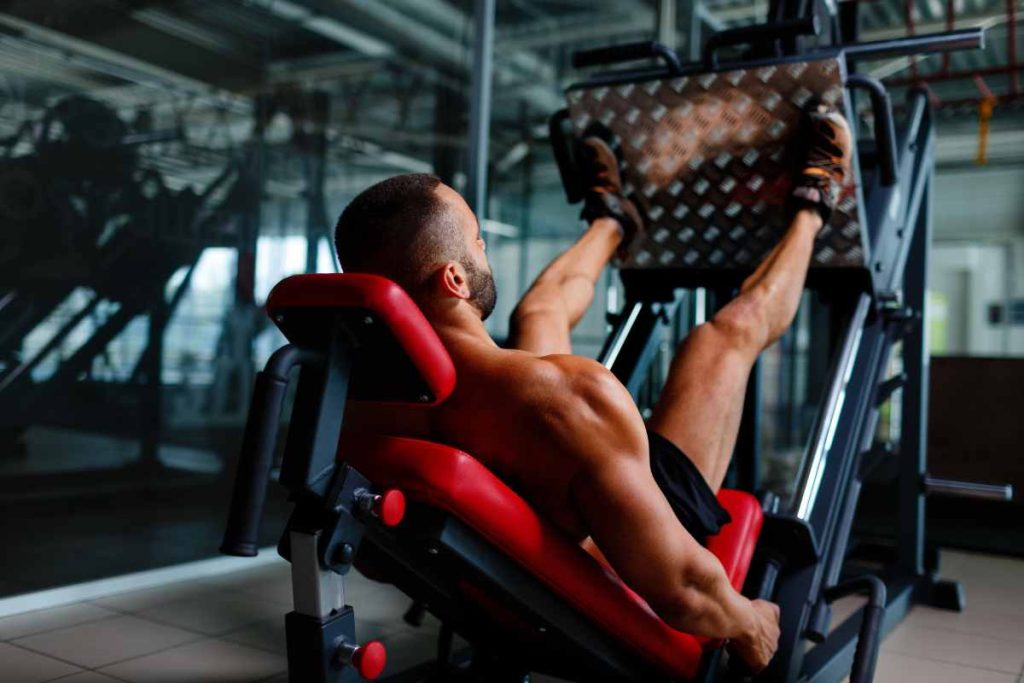
Leg Day is here, and it’s time to shred!
Nothing can help you add on the extra pounds like the leg press machine, a machine specifically built to place all of the focus squarely on your leg muscles and isolate your lower body for maximum power generation.
If you’re trying to take your lifting sessions to the next level, it’s a good idea to mix in leg presses (along with squats, lunges, and others) to really max out the weight.
Below, we’ll walk you step by step through what the leg press machine is, what types of machines exist, how to use the machine correctly, and, most important of all, how to avoid the mistakes that could decrease the effectiveness of your workout and increase injury risk.
By the end of this post, you’ll be an expert at using the leg press machine to build those monster quads.
Let’s jump right in.
What is a Leg Press Machine? (And Why Use It?)
The leg press machine is a machine that utilizes a sled secured to rails to place a great deal of weight safely on your legs.
Simply put, you sit on a bench/pad that supports your back and butt, place your legs on the sled, and push.
The rails allow the sled to slide up and down, lifting the weight, but keeps it limited to a single plane of motion.
This actually makes it safer for beginners (because of how easy it is) but is still highly effective at isolating your quads.
You might be wondering about the muscles worked in leg press exercises.
Typically, all of your leg muscles are engaged during the leg press:
- Quadriceps (prime movers)
- Gluteal muscles (secondary muscles)
- Hamstrings (secondary muscles)
- Calves (secondary muscles)
Why would you want to use the leg press machine over squats or lunges?
Some of the top leg press benefits include:
⭐ Safer than a squat.
Because the weight cannot move, there is far less risk of injury doing a leg press than a squat.
With the squat, there is greater strain on your back and knees, and if you don’t have the exact right form, there is a very real injury risk.
That makes leg presses a much safer—and more beginner-friendly—exercise.
⭐ Excellent isolation.
When you sit/lie on the leg press bench/pad, you’re essentially removing your upper body from the equation.
Your core and lower body don’t need to support your torso, so the focus of the exercise is squarely on your lower body.
Your core will need to engage fractionally to support your leg presses, but the design of the leg press bench ensures maximum isolation of your lower body.
⭐ Versatility.
Leg presses are chiefly focused on the quads, but adjusting your leg press machine feet placement can do wonders to engage the other leg muscles in greater measure.
It’s an incredibly versatile and easily adaptable exercise!
As you can see, there are many reasons to get excited about including the lep press machine in your workouts.
The Different Types of Leg Press Machines
There are three different types of leg press machines you’ll find at most gyms. These include:
Vertical Leg Press
The vertical leg press is designed with the back pad placed at floor level, and the sled loaded on the slide rails is placed directly above you.
You lie on your back with your feet straight up in the air, and push directly up and down (vertical movement).
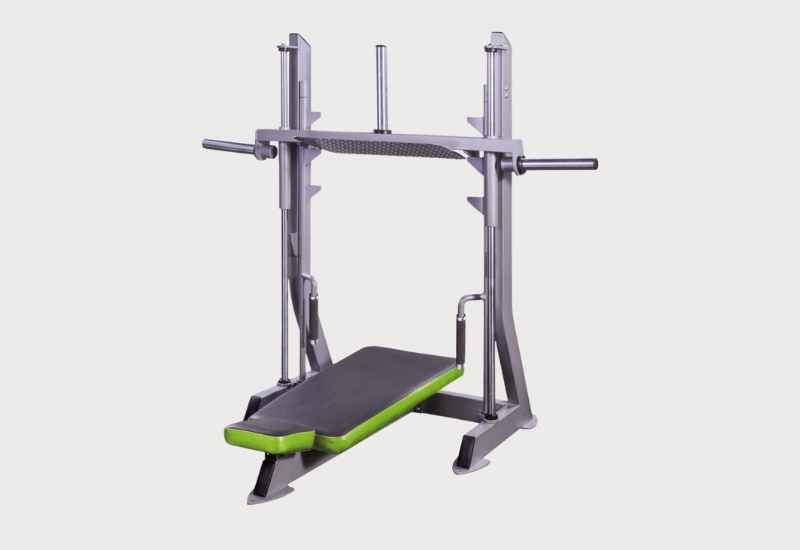
This ensures maximum gravity is weighing on your legs, and it is the closest to simulating the barbell squat.
Horizontal Leg Press
The horizontal leg press is designed with a seat that sits upright, and a sled that slides forward and backward on rails.
Typically, it’s a cable-based machine, which increases time under tension to maximize the effectiveness of the workout.
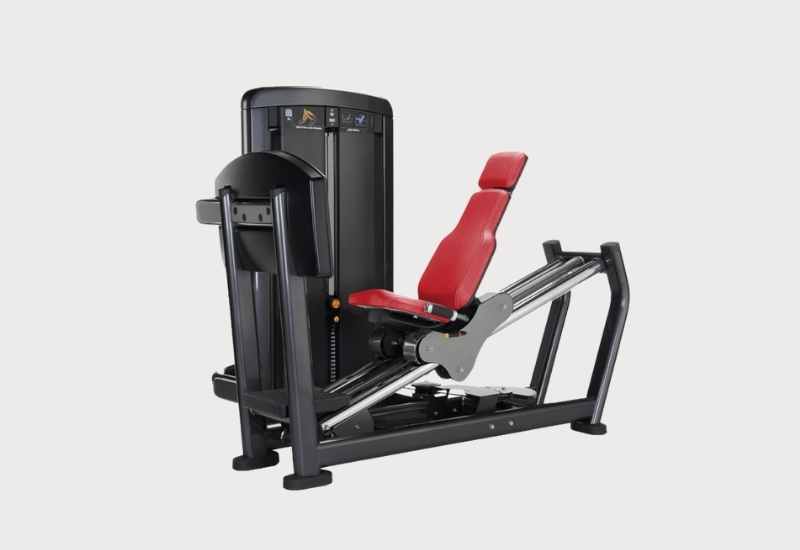
There is no direct weight placed on your body, however, so it’s safer for those with leg or knee injuries.
45-Degree Leg Press
The 45-degree leg press is, as its name suggests, designed with the sled and rail system set at a 45-degree incline.
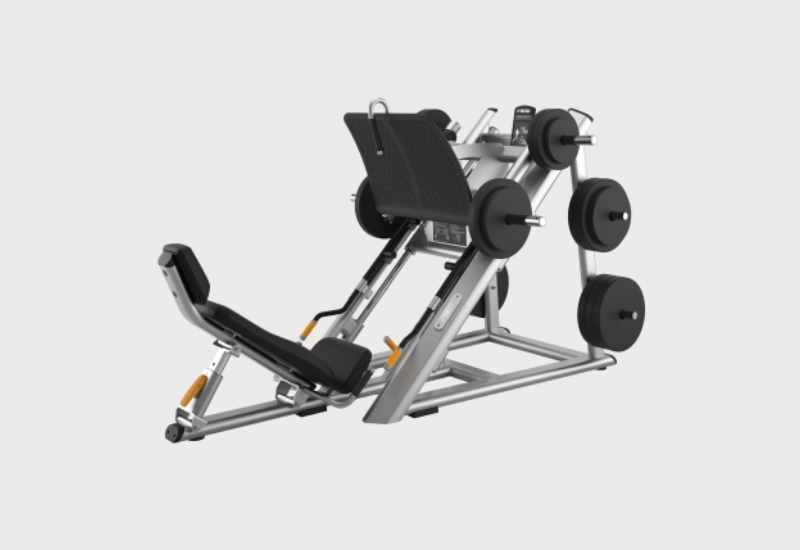
You lie on your back and press the weights up the 45-degree incline.
This is the leg press most commonly found in gyms and home gyms.
How to Use the Leg Press Machine Like a Pro
Time to get working and hit those sets like a BEAST!
Below, I’ll walk you step by step through how to use the leg press machine properly, including all the form and posture details that will help you stay safe while training with very heavy weights.
You’ll love how easy it is to master this exercise, and you can start adding serious amounts of weight in no time.
After you’ve gulped down your double-scoop serving of pre-workout and warmed up properly:
? Step 1: Load up. If you’re working with a horizontal leg press, set the weight stack to your desired weight. If you’re working with a 45-degree or vertical leg press, you’ll need to load the barbell plates on the machine by hand.
For those who are new to leg presses, it’s a good idea to start off with less weight at first. That way, you can master the form and posture. Once you’ve got the movement down just right, you can start adding more weight and really pushing it to the next level.
? Step 2: Assume the position. Sit on the pad with your head and back resting comfortably against the padding. Scoot your butt backwards until you are pressing fully against the back pad. Make sure your butt is flat against the seat—this will ensure the most effective isolation of your lower body muscles as you push.
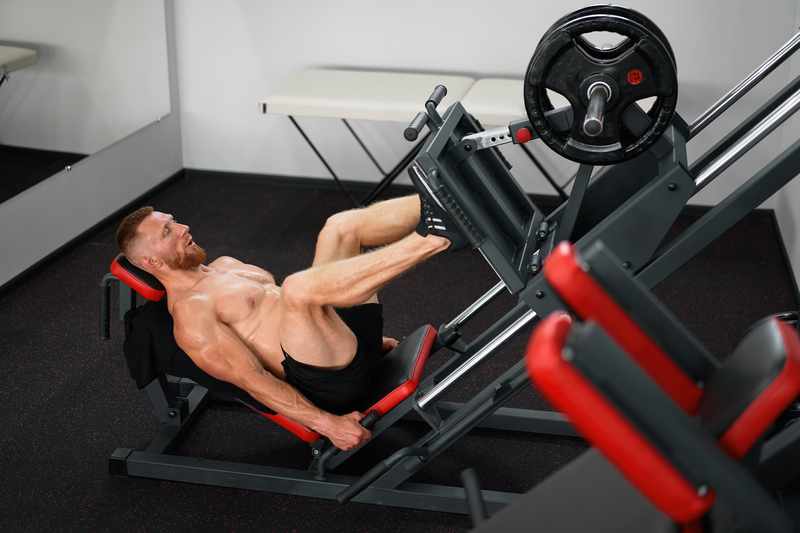
? Step 3: Plant your feet. For the sake of mastering the leg press, we’ll start with the “neutral” foot placement—i.e. in the center of the sled, with your knees bent at a 90-degree angle and your feet roughly shoulder width apart. You can always experiment with alternative foot placement to adapt the exercise later on, once you’ve got the form down right.
? Step 4: Lift the sled to unrack it. Push upward using your leg muscles, and extend your legs (WITHOUT locking your knees!) to lift the sled from its rack. Once it’s lifted, twist the safety handles outward to disengage the support. Now you’re ready to lift!
? Step 5: Lower toward you. Keep your toes and heels planted firmly on the sled, and inhale as you bend your legs to slowly lower the weight toward you. Lower until you feel your heels lifting off the sled or your butt rising off the seat. Stop before this happens!
? Step 6: PUSH! Exhale as you drive through your heels to press the sled upward. Try to keep your movement controlled (avoid explosive movement initially), and keep your presses controlled as you extend your legs.
Looking to hitting your glutes more on the leg press machine? Here are six tips for targeting your glutes on leg press
? Step 7: Stop at the top. Stop pushing just before your legs are fully extended—this maximizes muscle engagement and increases time under tension while also reducing the risk of knee injuries. Pause for a 1-count, adjust your position as needed, and get ready for another rep.
? Step 8: Repeat as desired. Ideally, you’ll want to work within the 4-6 rep range to develop power, 8-12 to develop strength, and 15-25 to develop endurance.
? Step 9: Lock the sled safely in place. On your last rep, extend your legs, and turn the safety handle to engage the support. Once the support is in place, lower the sled until it catches. With that, it’s safe to stand and move around.
And just like that, you’ve mastered the leg press!
Mistakes People Make When Using the Leg Press Machine
Here are a few of the most common mistakes that you should avoid:
Locking out your knees.
This not only takes the weight off your muscles (decreasing time under tension), but it increases the risk of knee joint strain.
NEVER lock out your knees, but always stop just before full extension.
Overloading.
If you add too much weight, you’ll end up straining so hard to lift that you’ll compromise your form and risk serious injury.
It’s always best to start with less weight and work your way safely up to your max in increments.
Letting your knees flare outward.
If your legs flare outward, it engages your hip muscles and decreases the focus on your quads.
This makes it less effective for building monster quads and isolating your leg muscles.
Your goal should be to maintain your knees in line with your hips and feet throughout the full exercise.
Lifting your butt.
If your butt lifts off the pad, it will lead to greater engagement of the lower back muscles, which increases the risk of lower back injuries.
The whole point of leg presses is to isolate the leg muscles.
Always adjust the seat/pad to make sure your butt can stay comfortably planted throughout, and stop lowering the sled before you feel your butt lifting.
Lifting your heels.
This is another common problem that occurs when you allow the sled to lower too far.
When this happens, your quads are no longer able to lift the weight alone, so you end up utilizing more of your glutes and lower back to start pushing back up.
Make sure your heels stay planted at all times to ensure proper form and maximum quad engagement.
Limiting your range of motion.
You should allow your legs to move through the full range of motion—from nearly full extension to full bend (knees at a 90-degree angle).
If you find you can’t do the full range of motion, it’s likely because you’ve overloaded the sled and are stopping yourself for fear of not being able to press back up.
Lower the weight and try again, this time really focusing on your form and movement.
How to Use the Leg Press Machine — FAQs
Can a beginner do leg press?
They absolutely can! Leg presses are actually safer for beginners than most of the leg press machine alternatives (like squats and lunges) because of the restricted movement of the sled and the support for your lower back.
As long as you follow the advice above, you should have no trouble mastering the leg press in just a few training sessions!
What is the starting weight on a leg press machine?
The starting weight on a leg press machine varies, with seated leg press machines starting at around 5-20lbs and angled leg press machines sled weights ranging anywhere from 20-180lbs.
Most commercial gyms have leg presses that lean towards the lighter side, in the range of around 20lbs.
That’s very light weight for anyone to work with, and you’ll find that you can easily start stacking more weight discs because of how strong your legs are (carrying around your own bodyweight).
(Read this article on how much the sled weighs on leg press machines for more information and machine-specific starting weights.)
The Bottom Line
Leg presses are one of the best lower body exercises you can do, no matter how experienced you are.
Beginner lifters will love how safe the exercise is, and how easy the form is to master. Intermediate lifters often rely on leg presses to help build up the quad power and leg muscles they need.
Expert and professional lifters typically use leg presses to maximize power generation and isolate the quads to increase strength and size gains.
Wherever you are on your weightlifting journey, the leg press machine is definitely a tool you want to include in your arsenal!
More Leg Press Guides and Resources
Leg Press vs Hack Squat: Pros, Cons, and Differences for Monster Leg Muscles. The leg press and hack squat are both excellent exercises for developing strong leg muscles. But which one is for you? Read on to see the pros and cons of each.